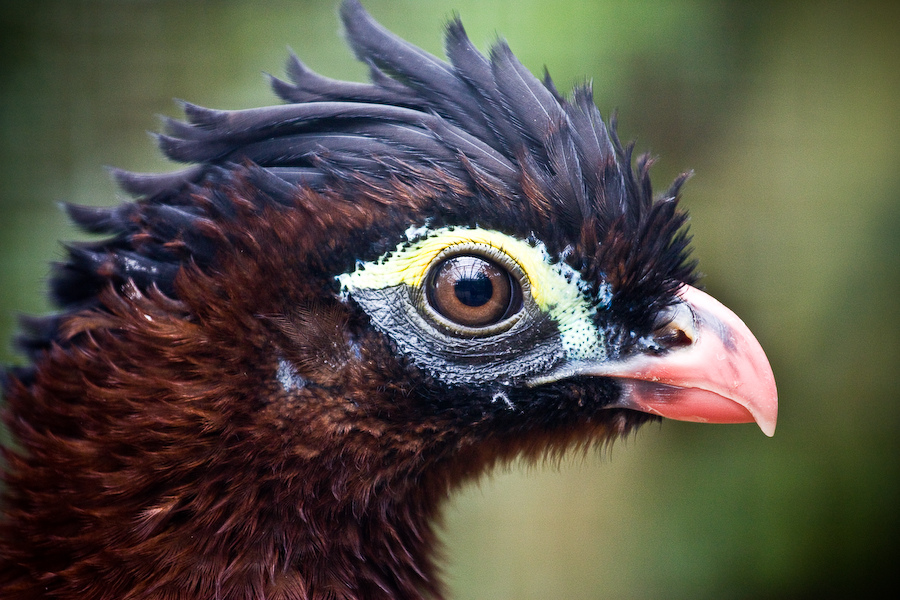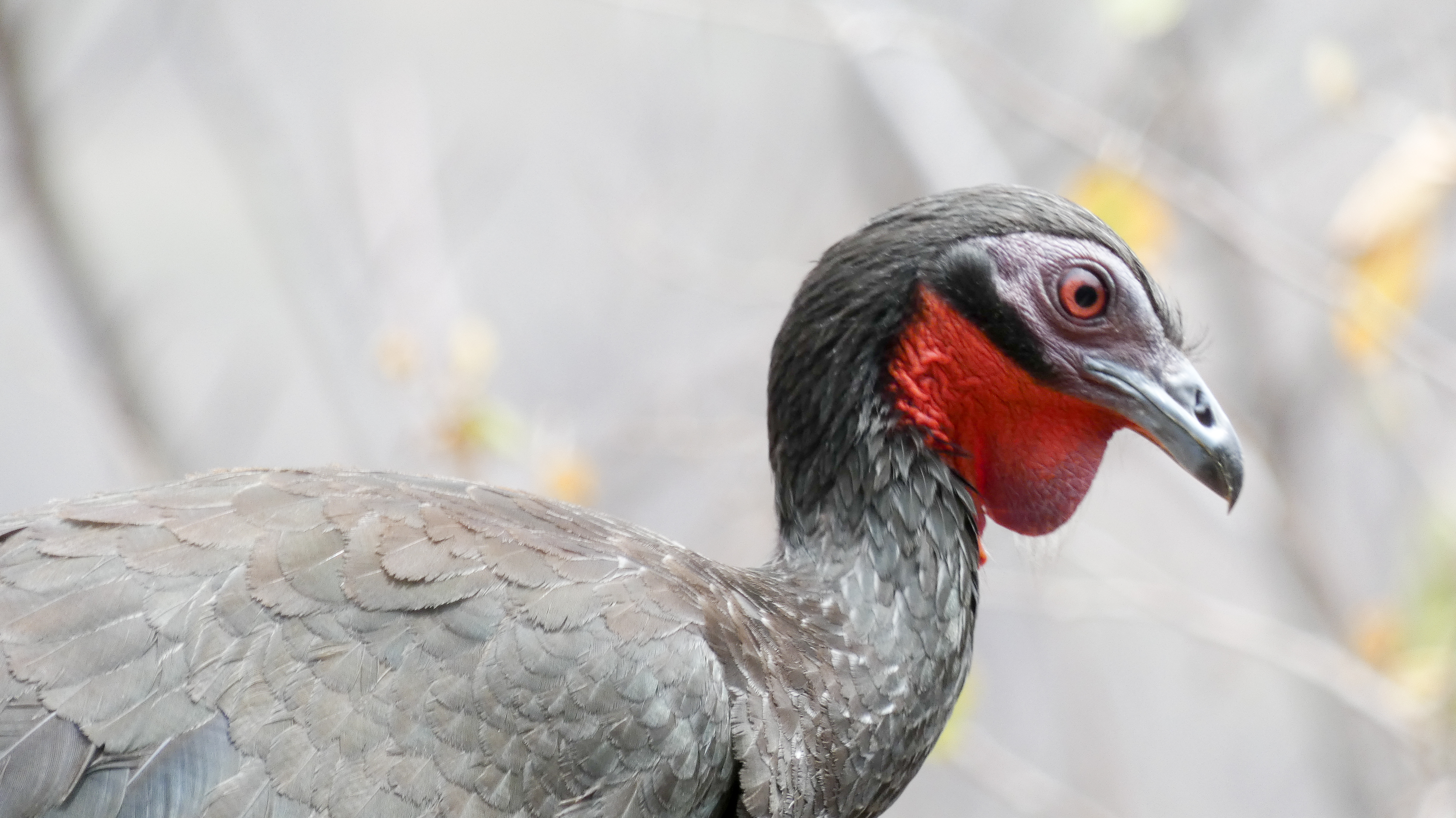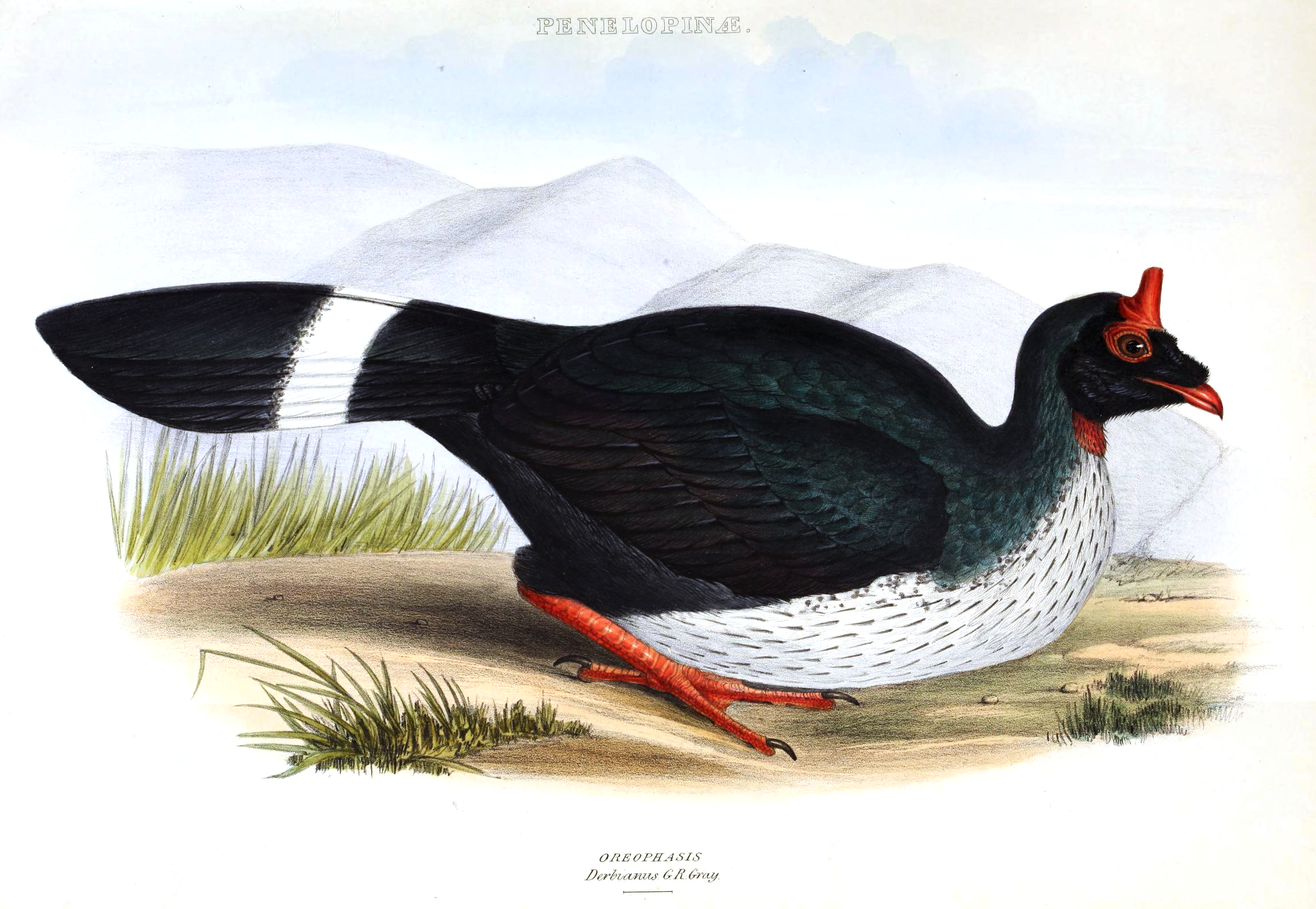|
Cracidae
The chachalacas, guans and curassows are birds in the family Cracidae. These are species of tropical and subtropical Central and South America. The range of one species, the plain chachalaca, just reaches southernmost parts of Texas in the United States. Two species, the Trinidad piping guan and the rufous-vented chachalaca occur on the islands of Trinidad and Tobago respectively. Systematics and evolution The family Cracidae was introduced (as Craxia) by the French polymath Constantine Samuel Rafinesque in 1815. The Cracidae are an ancient group related to the Australasian mound-builders. They are sometimes united with these in a distinct order, "Craciformes", but this is not supported by more recent research which suggests that either is a well-marked, basal lineage of Galliformes. Phylogeny Cladogram based on the study by De Chen and collaborators published in 2021. The numbers of species are from the list maintained by Frank Gill, Pamela Rasmussen and David Donsker on ... [...More Info...] [...Related Items...] OR: [Wikipedia] [Google] [Baidu] |
Galliformes
Galliformes is an order of heavy-bodied ground-feeding birds that includes turkeys, chickens, quail, and other landfowl. Gallinaceous birds, as they are called, are important in their ecosystems as seed dispersers and predators, and are often reared by humans for their meat and eggs, or hunted as game birds. The order contains about 290 species, inhabiting every continent except Antarctica, and divided into five families: Phasianidae (including chicken, quail, partridges, pheasants, turkeys, peafowl (peacocks) and grouse), Odontophoridae (New World quail), Numididae (guinea fowl), Cracidae (including chachalacas and curassows), and Megapodiidae (incubator birds like malleefowl and brush-turkeys). They adapt to most environments except for innermost deserts and perpetual ice. Many gallinaceous species are skilled runners and escape predators by running rather than flying. Males of most species are more colorful than the females, with often elaborate courtship behavio ... [...More Info...] [...Related Items...] OR: [Wikipedia] [Google] [Baidu] |
Penelopinae
The guans are a number of bird genera which make up the largest group in the family Cracidae. They are found mainly in northern South America, southern Central America, and a few adjacent Caribbean islands. There is also the peculiar horned guan (''Oreophasis derbianus'') which is not a true guan, but a very distinct and ancient cracid with no close living relatives (Pereira ''et al.'' 2002). Systematics and evolution The evolution of the group is fairly well resolved due to comprehensive analyses of morphology, biogeography, and mt and nDNA sequences (Pereira ''et al.'' 2002, Grau ''et al.'' 2005). The position of ''Penelopina'' and ''Chamaepetes'' - peculiar genera of which the former, uniquely among guans and more in line with curassows, shows pronounced sexual dimorphism - relative to each other is not determinable with certainty at present, but all evidence suggests that they are the basalmost guans. Their distribution is fairly far northwards, with 2 of their 3 species ... [...More Info...] [...Related Items...] OR: [Wikipedia] [Google] [Baidu] |
Trinidad Piping Guan
The Trinidad piping guan (''Pipile pipile'') locally known as the pawi, is a bird in the chachalaca, guan and curassow Family (biology), family Cracidae, Endemism, endemic to the island of Trinidad. It is a large bird, somewhat resembling a turkey in appearance, and research has shown that its nearest living relative is the blue-throated piping guan from South America. It is a mainly arboreal species feeding mostly on fruit, but also on flowers and leaves. At one time abundant, it has declined in numbers and been Extinction, extirpated from much of its natural range and the International Union for Conservation of Nature has rated the bird as "critically endangered". Description This is a medium-sized cracid, 60 cm in length, and similar in general appearance to a turkey (bird), turkey, with a thin neck and small head. It is mainly black with a purple gloss. The large Crest (feathers), crest is blackish, edged with white, and there are large white wing patches. The bare face ... [...More Info...] [...Related Items...] OR: [Wikipedia] [Google] [Baidu] |
Pipile
The piping guans are a bird genus, ''Pipile'', in the family Cracidae. A recent study, evaluating mtDNA, osteology and biogeography data concluding that the wattled guan belongs in the same genus as these and is a hypermelanistic piping guan. Thus, ''Pipile'' became a junior synonym of ''Aburria'', though this conclusion was not accepted by the South American Checklist Committee, or evaluated by the IOC, so the classification remains in Pipile. The same results also showed that the light-faced taxa ''pipile, cumanensis'' and ''cujubi'' are not, as was sometimes suggested, conspecific. However, free interbreeding between '' A. cujubi'' and '' A. cumanensis grayi'' in eastern Bolivia, creating a "hybrid swarm", casts doubt on this conclusion for the two species named. It was possible to confidently resolve that the white-faced species form a clade, whereas the more basal black-faced forms are of less certain relationship. Possibly, the black-fronted piping guan is the basalmost ... [...More Info...] [...Related Items...] OR: [Wikipedia] [Google] [Baidu] |
Cracinae
Curassows are one of the three major groups of cracid birds. They comprise the largest-bodied species of the cracid family. Three of the four genera are restricted to tropical South America; a single species of ''Crax'' ranges north to Mexico. They form a distinct clade which is usually classified as the subfamily Cracinae. Evolution In line with the other 3 main lineages of cracids (chachalacas, true guans, and the horned guan), mt and nDNA sequence data indicates that the curassows diverged from their closest living relatives (probably the guans) at some time during the Oligocene, or c.35–20 mya (Pereira ''et al.'' 2002). This data must be considered preliminary until corroborated by material (e.g. fossil) evidence however. What appears certain from analysis of the molecular data, calibrated against geological events that would have induced speciation is that there are 2 major lineages of curassows: one containing only ''Crax'', and another made up of ''Mitu'' and ''Pau ... [...More Info...] [...Related Items...] OR: [Wikipedia] [Google] [Baidu] |
Aburria
The wattled guan (''Aburria aburri'') is a species of bird in the family Cracidae. It is a fairly large black cracid with blue-based, black-tipped beak and a long, red-and-yellow wattle. It is found in Colombia, Ecuador, Peru, and Venezuela. Its natural habitats are subtropical or tropical moist lowland forest and subtropical or tropical moist montane forest. The wattled guan is a fairly shy species that is mostly seen when it perches on the outer edge of the canopy from a distance. Like many tropical forest birds, it is heard more often than seen. It is threatened by habitat destruction and the IUCN has assessed its conservation status as being "near threatened". Description The wattled guan is recognisable by the elongated red and yellow fleshy wattle that dangles from its throat. It is a large bird with a long tail, about long and weighing between . The plumage is black, the beak is blue and the feet are flesh-coloured. Distribution and habitat The wattled guan is endem ... [...More Info...] [...Related Items...] OR: [Wikipedia] [Google] [Baidu] |
Penelope (genus)
''Penelope'' is a bird genus in the family Cracidae consisting of a number of large turkey-like arboreal species, the typical guans. The range of these species is in forests from southern Mexico to tropical South America. These large birds have predominantly brown plumage and have relatively small heads when compared to the size of their bodies; they also bear a characteristic dewlap. Body lengths are typically 65 to 95 centimeters. Most of the genus members have a typically raucous honking call. A number of the genus members are endangered species and at least one is critically endangered, usually due to tropical deforestation and hunting. In the case of several species the estimated populations are as low as a few 1000 mature birds, spread over a considerable area. Because of the scarcity of many of the genus members and also due to the habitat being often in deep or high altitude forests, little is known about some of the species habits and reproduction; in fact, some s ... [...More Info...] [...Related Items...] OR: [Wikipedia] [Google] [Baidu] |
Penelopina
The highland guan (''Penelopina nigra'') is a species of bird in the family Cracidae. It is found in the highlands of El Salvador, Guatemala, Honduras, southern Mexico, and Nicaragua. Its natural habitat is subtropical or tropical moist montane forest. Its population has declined much in recent times: Listed as a species of Least Concern in 1994, it was uplisted to Near Threatened in 2000 and, as it was determined to be less common than previously believed, to Vulnerable in the 2007 IUCN Red List.See BirdLife International (2004, 2007a,b). Description The highland guan grows to a length of . The plumage of the male is black, the upper parts glossed with green or blue, the underparts rather duller. The iris of the eye is reddish-brown and there is reddish-brown or purplish bare skin around and behind the eye. The beak, the bare skin on the throat, the large wattle, the legs and feet are reddish-orange. The female, by contrast, is black, heavily mottled and barred with reddish-b ... [...More Info...] [...Related Items...] OR: [Wikipedia] [Google] [Baidu] |
Oreophasis
The horned guan (''Oreophasis derbianus'') is a large, turkey-like bird native to Central America. It is the only species in the genus ''Oreophasis''. Taxonomy The holotype specimen of "''Oreophasis Derbianus'' " G.R. GrayGen. Bds., 3, 1844, p.(485). is held in the collections of National Museums Liverpool at World Museum, with accession number D210. The specimen was collected from Volcán de Fuego, Guatemala by Don Joaquin Quinones circa 1843 and came to the Liverpool national collection via the 13th Earl of Derby’s collection which was bequeathed to the people of Liverpool. Phylogeny The horned guan is not a true guan, but merely resembles these birds most in overall shape and color, whereas the horn is more reminiscent of the helmeted curassows. In fact, this species is the only survivor of a very ancient lineage of cracids that has been evolving independently from all other living members of this family for at least 20 million years, and possibly as much as 40 million ... [...More Info...] [...Related Items...] OR: [Wikipedia] [Google] [Baidu] |
Megapode
The megapodes, also known as incubator birds or mound-builders, are stocky, medium-large, chicken-like birds with small heads and large feet in the family Megapodiidae. Their name literally means "large foot" and is a reference to the heavy legs and feet typical of these terrestrial birds. All are browsers, and all but the malleefowl occupy wooded habitats. Most are brown or black in color. Megapodes are superprecocial, hatching from their eggs in the most mature condition of any bird. They hatch with open eyes, bodily coordination and strength, full wing feathers, and downy body feathers, and are able to run, pursue prey, and in some species, fly on the same day they hatch. Description Megapodes are medium-sized to large terrestrial birds with large legs and feet with sharp claws. The largest members of the clade are the species of '' Alectura'' and '' Talegalla''. The smallest are the Micronesian scrubfowl (''Megapodius laperouse'') and the Moluccan scrubfowl (''Eulipoa wal ... [...More Info...] [...Related Items...] OR: [Wikipedia] [Google] [Baidu] |
Yellow-knobbed Curassow
The yellow-knobbed curassow (''Crax daubentoni'') is a species of bird in the family Cracidae, the chachalacas, guans, and curassows. It is found in Colombia and Venezuela. Taxonomy and systematics The yellow-knobbed curassow was formerly classified as a subspecies of blue-billed curassow (''Crax alberti''). It is monotypic. A few subspecies previously proposed for it were determined to be hybrids or aberrant individuals and so were not adopted.del Hoyo, J. and G. M. Kirwan (2020). Yellow-knobbed Curassow (''Crax daubentoni''), version 1.0. In Birds of the World (J. del Hoyo, A. Elliott, J. Sargatal, D. A. Christie, and E. de Juana, Editors). Cornell Lab of Ornithology, Ithaca, NY, USA. https://doi.org/10.2173/bow.yekcur1.01 retrieved October 1, 2021 Description The yellow-knobbed curassow is long. Males usually weigh between but one weighed only . A female weighed . The male is the only curassow with a knobbed yellow cere and wattle. Males and females are mostly black ... [...More Info...] [...Related Items...] OR: [Wikipedia] [Google] [Baidu] |
Rufous-vented Chachalaca
The rufous-vented chachalaca (''Ortalis ruficauda'') is a member of an ancient group of birds of the family Cracidae, which are related to the Australasian mound builders. It inhabits northeast Colombia and northern Venezuela where it is called guacharaca, and the island of Tobago in Trinidad and Tobago where it is known as the cocrico and is one of the country's two national birds (being featured on the country's coat of arms). It is also found on Bequia and Union Island in the Grenadines where it may have been introduced. Habitat The rufous-vented chachalaca is a largely arboreal species found in forest and woodland, but it is also found in more open dry scrubby areas. This combined with relatively low hunting pressure, make it far less vulnerable than larger members of the family, notably curassows. Description These are medium-sized birds, similar in general appearance to turkeys, with small heads, long strong legs and a long broad tail. They are typically 53–58 c ... [...More Info...] [...Related Items...] OR: [Wikipedia] [Google] [Baidu] |
_(6436435841)_(cropped).jpg)






